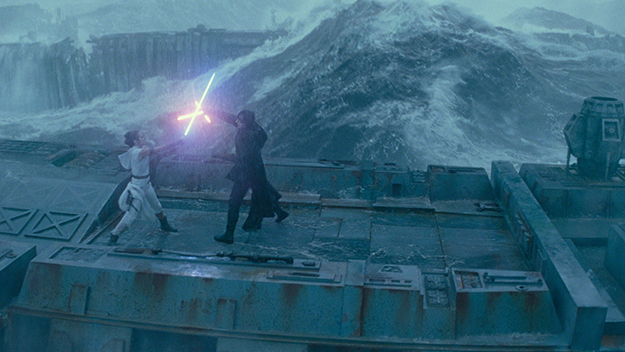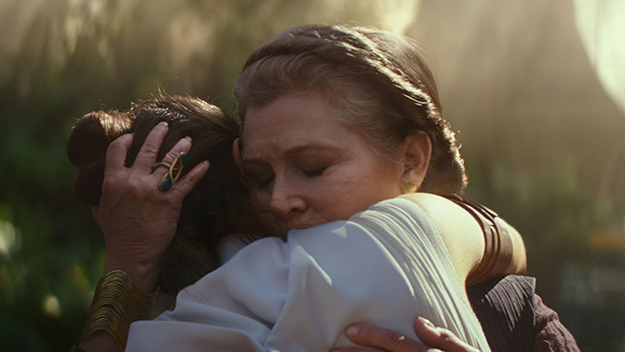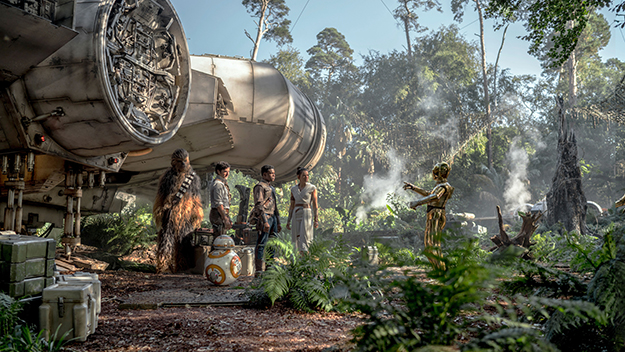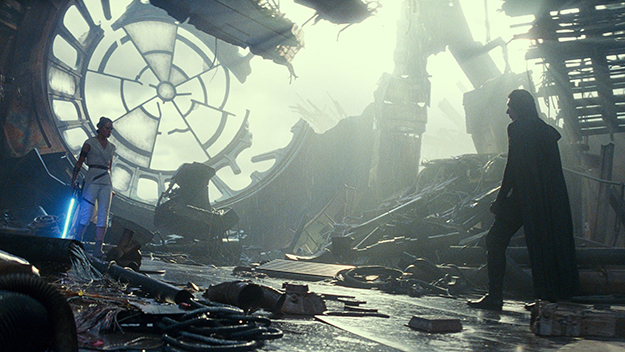Deep Focus: Star Wars: The Rise of Skywalker

Images from Star Wars: The Rise of Skywalker Film (J.J. Abrams, 2019)
When a voice in the trailer intoned, “No one’s ever really gone,” I didn’t think it was meant literally. J.J. Abrams’s mechanical, nonsensical Star Wars: The Rise of Skywalker contains so many resurrections it’s a wonder Disney and Lucasfilm didn’t push back the release date from Christmas to Easter. (They had originally delayed it from Memorial Day to Christmas.) The opening crawl proclaims, “The dead talk!” That’s an understatement. We all thought Emperor Palpatine (Ian McDarmid) was slain in Star Wars: Return of the Jedi (1983). It turns out the Emperor has been amassing planet-killing spacecraft and shadowy armies—they look like Vaderesque clones—to transform the tyrannical First Order into “the Final Order.” Now that ultra-furious Kylo Ren (Adam Driver) is the First Order’s Supreme Leader, will he bring his troops into the fold?
Meanwhile, Princess Leia (Carrie Fisher) has been overseeing the Jedi training of Rey (Daisy Ridley) and strengthening what’s left of the Resistance with the help of returning heroes Poe (Oscar Isaac), Finn (John Boyega) and Rose (Kelly Marie Tran, though if you blink three times you’ll miss her). What connects all these characters is not a rich or logical plot, but a cosmic clothesline on which Abrams hangs obligatory action scenes and exotic set pieces, supposedly rousing demonstrations of rebel solidarity and camaraderie, and an unconscionable number of apparitions, hallucinations, traumatic flashbacks, and disembodied communications.
Abrams doesn’t build momentum: he packages spurious energy into a bloated circus. The result: a plummeting comedown from Star Wars: The Last Jedi (2017), by far the most beautiful and emotional entry in the Skywalker trilogy that started with Abrams’s Star Wars: The Force Awakens (2015). Writer-director Rian Johnson, in The Last Jedi, expertly tied the moral imbalance in the cosmos to the raging depths within Rey and Kylo Ren. Johnson also handed Mark Hamill’s Luke Skywalker a simple, lucid lecture on the Force: he taught Rey to “reach out” to the elements of the universe “with your feelings” and experience the energy “between it all” and “inside you.” (Yes, the Beatles had it right: the Force, like life, “flows on within you and without you.”) Some of the most affecting moments in The Last Jedi came when Rey and Kylo connected long-distance via some mystic pipeline and when Luke recharged his own mind-bending powers to full Force.

Abrams’s The Rise of Skywalker repeats the same or comparable motifs without visual or dramatic oomph or clarity. When Rey briefly faces a vicious doppelganger, the imagery is so pedestrian it’s as if she sees herself as an evil twin made up for Halloween. Worse, Abrams and his cowriter Chris Terrio (Argo), who share story credit with Colin Trevorrow and Derek Connolly, wildly overdraw on our willing suspension of disbelief as they exhume expired characters or revive moribund warriors after mortal combat. A modified Romeo and Juliet-type climax earns a thunderous bad laugh.
This movie means to cap not just the Rey odyssey that started in The Force Awakens but also the entire “Skywalker saga” that began with A New Hope (1977) or The Phantom Menace (1999), depending on how you’re counting. The storytelling lacks originality and conviction. It simply connects the dots between the Skywalker clan’s legacy and the broader history of freedom vs. repression in Lucas’s galaxy far, far, away. In a video interview from the electronic press kit, Abrams says that what’s central to the series’ appeal is the idea that “the most average among us can be the most extraordinary person” and conquer “terrifying evil.” Yet in his and Terrio’s script, the capacity to channel the Force passes down via bloodlines—a sop to true believers who felt The Last Jedi was being disrespectful when Luke said the Force was bigger than any clan or tribe and did not “belong to the Jedi.”
As a writer-director, Abrams focuses on providing the greatest possible number of nostalgic payoffs to Star Wars sentimentalists. The way he sucks up to the fan base is transparent enough to backfire with everyone except zealots. Any salvageable character wins a piece of redemption. The Rise of Skywalker indulges series devotees in “fan service,” then raises it to the level of a veritable fan Mass. It’s too much to swallow.

Of course, sidelights still glitter. The globular clownishness of the “astromech droid” called BB-8 remains a welcome contribution to the series, and this time Abrams gives it a scampish foil named D-O: its head resembles the shade to a utilitarian desk lamp and its body looks like a tiny unicycle. We get to savor the spirited shaggy doggishness of Chewbacca the Wookie (played here, as in Jedi, by Joonas Suotamo) and the piquant arcade-game squawks and squeals of R2-D2 (Jimmy Vee). Partway through, Anthony Daniels’s endearingly fussy C-3PO has his memory wiped, resulting in the only funny running gag. Right before, C-3PO pauses and tells Poe he’s “taking one last look, sir, at my friends.” We respond to the poignancy of the moment even if we don’t feel the same way about Poe and his pals.
Most of the performers, particularly Isaac and Boyega, are less on an actors’ holiday than a holiday from acting. The movie means for us to embrace Poe, Finn, and Chewie as a team, and to chortle over Poe and Finn’s arrested-adolescent buddyhood. It’s supposed to be a treat to see them work together after being separated through much of The Last Jedi. But Isaac and Boyega look like happy campers, and that’s it. Isaac makes one last-minute attempt at style when he cocks an eye at Keri Russell’s svelte new gangster character, but it would take a better director than Abrams for him to register as a natural, like Dean Martin. Billy Dee Williams glides back into the series as Lando Calrissian and, for a minute or two, achieves what Isaac aims for without breaking a sweat. Ridley and Driver match each other in intensity, but their vibrations get hoovered up inside a vacuum. The lack of atmosphere betrays their efforts to create urgent sexual tension out of nothing. Fisher, so wonderful in Last Jedi, comes off as overly sweet and bland in a performance reportedly put together from The Force Awakens’ outtakes. Both Russell and Naomi Ackle, as another new female character, boast different styles of Amazonian allure, but nary a shred of personality.

What could the actors do with Abrams and Terrio’s script? It’s a lot less interesting than the runup novel to The Rise of Skywalker, Rebecca Roanhorse’s Resistance Reborn, which at least does an honest job of furthering the evolution Johnson initiated for Poe in The Last Jedi, from swaggering hot shot to sober commander. Abrams appears intent to stay within Saturday-matinee parameters. He and his team travelled to Wadi Rum in Jordan (one of the prime locations for Lawrence of Arabia) to create the desert planet of Pasaana, which becomes the backdrop for an eye-catching chase. But there’s no resonance to the spectacle, because Abrams, like George H.W. Bush, isn’t into “the vision thing.” In The Last Jedi, Johnson operates like a pop poet; his primal use of the color red made me think of Ingmar Bergman’s statement that “he pictured the inside of the soul as a moist membrane in shades of red.” In The Rise of Skywalker, Abrams labors like an aggregator, suturing bits and pieces from the other films. He may turn a destroyed Death Star from the first trilogy into a key location, but it barely summons a dull menace.
Ambition isn’t everything. Ron Howard’s unfairly maligned Solo: A Star Wars Story (2018) proved that with genuine wide-screen film sense and gusto, it’s possible to spin the most familiar Star Wars characters into a sparkling entertainment. Solo was deemed a failure because it flopped at the box office. And The Last Jedi has proven so divisive with fans that it may scare Disney and Lucasfilm away from handing big-budget projects to budding auteurs.
If The Rise of Skywalker becomes the template for the series going forward, the only Star Wars-related film to look forward to would be Mel Brooks’s Spaceballs 2: The Search for More Money.
Michael Sragow is a contributing editor to Film Comment and writes its Deep Focus column. He is a member of the National Society of Film Critics and the Los Angeles Film Critics Association.







